Introduction: A Foundational Figure
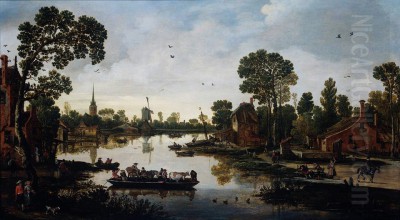
Esaias van de Velde stands as a pivotal figure in the history of Dutch art, particularly celebrated as one of the primary architects of realistic landscape painting during the Dutch Golden Age. Baptized in Amsterdam on May 17, 1587, and buried in The Hague on November 18, 1630, his relatively short life spanned a period of immense artistic innovation in the newly independent Dutch Republic. Van de Velde's work marks a significant departure from the prevailing Mannerist traditions, ushering in a new era focused on the direct observation and faithful depiction of the local Dutch environment. His influence extended profoundly to his contemporaries and the subsequent generation of landscape painters, solidifying his legacy as a true innovator.
Early Life and Artistic Formation
Esaias was born into an artistic family in Amsterdam. His father, Hans van de Velde, was an artist who had fled Antwerp around 1585, likely due to the religious persecution of Protestants following the city's fall to Spanish Catholic forces. This background placed the family within a community of Flemish émigrés who brought diverse skills and artistic traditions to the Northern Netherlands. While details of Esaias's earliest training are not definitively documented, it is highly probable that he received initial instruction from his father.
Art historians widely speculate that Esaias further honed his skills under the guidance of Gillis van Coninxloo III, a prominent landscape painter also of Flemish origin, who had settled in Amsterdam. Coninxloo was known for his densely wooded, somewhat fantastical landscapes, still rooted in the tradition of artists like Pieter Bruegel the Elder. Another potential influence, or perhaps even teacher, was David Vinckboons, another Flemish émigré in Amsterdam, known for his landscapes and genre scenes often featuring elegant figures and lively narratives. Exposure to these established masters would have provided Van de Velde with a strong technical foundation, even as he began to forge his own distinct path.
The Haarlem Period: Seeds of Realism
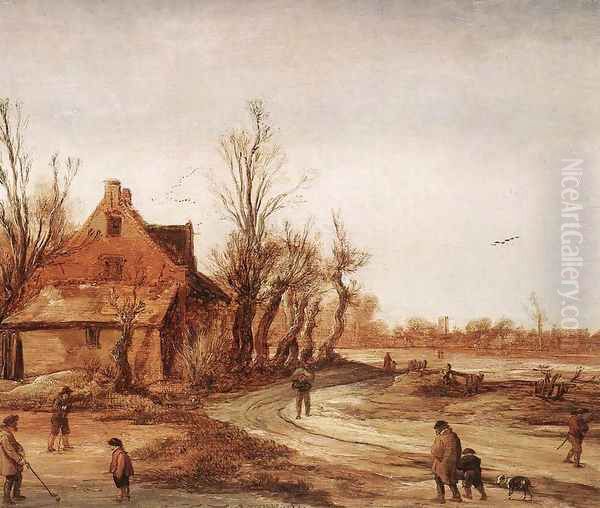
Around 1609, following his father's death, Esaias van de Velde moved with his mother to Haarlem. This city was rapidly becoming a major center for artistic innovation, particularly in landscape and genre painting. It was here that Van de Velde's mature style began to truly emerge. In 1612, he was admitted as a master into the Haarlem Guild of Saint Luke, a significant milestone confirming his status as an independent professional artist. His period in Haarlem, lasting until about 1618, was incredibly formative.
During these years, Van de Velde decisively broke away from the Mannerist conventions inherited from artists like Coninxloo or the Antwerp school exemplified by figures such as Paul Bril. He abandoned the high viewpoints, dramatic mountain ranges, and vibrant, often unnaturalistic color palettes characteristic of the older style. Instead, he adopted lower viewpoints, focused on recognizably Dutch scenery – flat countryside, dunes, canals, and villages – and employed a more subdued, naturalistic range of colors. This shift towards realism was revolutionary and laid the groundwork for the dominant trends in Dutch landscape painting for decades to come.
Haarlem provided a stimulating environment. He worked alongside other innovative artists, most notably Willem Buytewech, known as "Geestige Willem" (Witty Willem). Buytewech excelled in drawing and printmaking, and specialized in fashionable genre scenes, particularly "merry companies" – depictions of elegant young people enjoying themselves. There appears to have been a degree of mutual influence between Van de Velde and Buytewech, particularly in their shared interest in depicting contemporary life and figures within landscape or architectural settings. It was also during his Haarlem period that Van de Velde likely taught Jan van Goyen, who would become one of the most important landscape painters of the next generation.
The Hague: Maturity and Recognition
In 1618, Esaias van de Velde relocated to The Hague, the administrative center of the Dutch Republic and the seat of the court of the Princes of Orange. He remained in The Hague for the rest of his life, continuing his prolific output. His move may have been motivated by the prospect of patronage from the court or the city's affluent residents. While direct court commissions are not extensively documented, his presence in The Hague certainly placed him at the heart of political and social power.
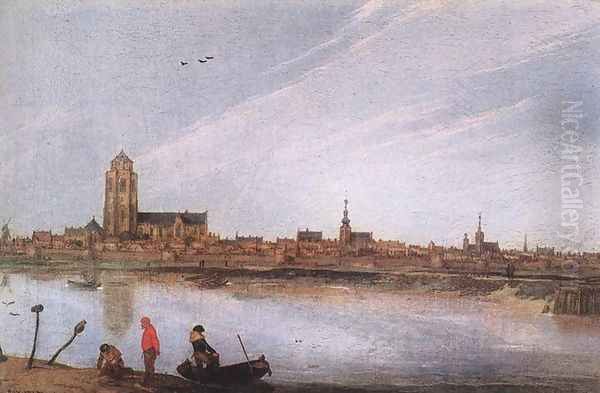
His artistic practice continued to evolve, though the fundamental principles of realism established in Haarlem remained central. He produced a wide array of works, including landscapes, winter scenes, genre paintings (such as outdoor parties and military encampments), and cavalry skirmishes. His reputation grew, and his works were sought after by collectors. He continued to refine his technique, demonstrating remarkable skill in rendering textures, atmospheric effects, and the interplay of light and shadow. His time in The Hague solidified his position as a leading master of the new Dutch school of painting.
Artistic Style: Defining Dutch Realism
Esaias van de Velde's primary contribution lies in his pioneering role in developing a distinctly Dutch form of landscape realism. His style is characterized by several key features that distinguished it from earlier traditions and influenced subsequent artists. He embraced the local, depicting the specific topography and atmosphere of the Dutch countryside rather than imaginary or idealized foreign vistas. This focus on the familiar resonated with the burgeoning national identity of the Dutch Republic.
Compositionally, Van de Velde often employed low horizons, which gave a greater sense of space and prominence to the sky – a feature that would become characteristic of much Dutch landscape painting. He frequently utilized diagonal lines, such as roads, rivers, or canals receding into the distance, to create a sense of depth and lead the viewer's eye into the scene. Simple, often triangular compositional structures provided clarity and balance. His approach felt more direct and less artificially constructed than the complex, layered compositions of Mannerist landscapes.
His handling of light and color was also innovative. While his palette was generally brighter and more varied than the later "tonal phase" painters like Van Goyen or Salomon van Ruysdael, it was significantly more restrained and naturalistic than the often jewel-like colors of his Flemish predecessors. He paid close attention to the effects of natural light, capturing the subtle nuances of different times of day and weather conditions. His ability to render atmospheric perspective, where distant objects appear hazier and cooler in tone, added to the realism of his scenes.
Furthermore, Van de Velde was a skilled figure painter, populating his landscapes with lively and accurately observed people engaged in everyday activities – peasants working, travelers on a road, skaters on ice, soldiers resting. These figures are not mere accessories but integral parts of the scene, contributing to the overall sense of realism and narrative interest. This integration of landscape and human activity was a hallmark of his work.
Versatility in Subject Matter
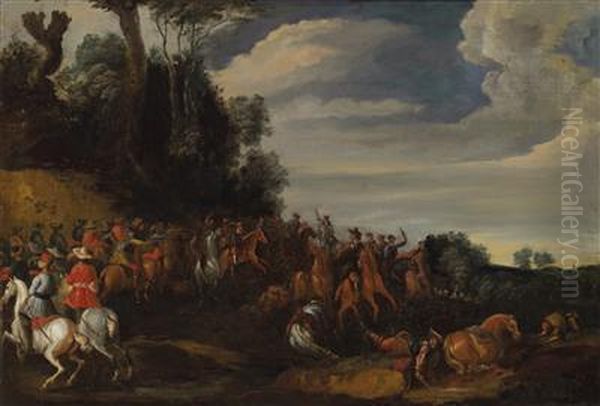
While best known for his landscapes, Esaias van de Velde demonstrated considerable versatility in his choice of subjects, reflecting the diverse tastes of the Dutch art market. His pure landscapes often depict serene views of the Dutch countryside, featuring cottages, windmills, rivers, and dunes under expansive skies. These works capture the quiet beauty and specific character of the Netherlands.
Winter landscapes were a particularly popular genre in which Van de Velde excelled. Following the tradition established by Pieter Bruegel the Elder, he depicted frozen canals and rivers bustling with activity – skaters, sleds, golfers playing "kolf" on the ice, and villagers going about their winter chores. These scenes offered opportunities to explore specific atmospheric effects, the stark beauty of the winter light, and the communal aspects of Dutch life during the cold season. His Winter Landscape paintings are among his most celebrated works.
Van de Velde also produced numerous genre scenes, often set outdoors. His "buitenpartijen" or garden parties depict elegantly dressed figures socializing, dining, or playing music in park-like settings, sometimes near stately homes. These works share affinities with those of Willem Buytewech and reflect the leisurely pursuits of the upper classes. Additionally, he painted cavalry skirmishes and scenes of soldiers resting or ambushing travelers, subjects popular during a time marked by the Eighty Years' War. These works showcase his ability to handle dynamic action and group compositions.
Representative Works
Several paintings exemplify Esaias van de Velde's style and importance. The Ferry Boat (1622, Rijksmuseum, Amsterdam) is often cited as a landmark work of early Dutch realism. It depicts a simple, everyday scene: a ferry carrying passengers and livestock across a river near a village. The low viewpoint, the naturalistic rendering of the water and sky, the carefully observed figures, and the overall sense of tranquil, ordinary life mark a clear break from older traditions. The composition is balanced and harmonious, drawing the viewer into the peaceful Dutch countryside.
His various Winter Landscape paintings (examples in the Rijksmuseum, Mauritshuis, National Gallery London, and elsewhere) showcase his mastery of this theme. A typical example might feature a wide frozen waterway under a grey winter sky, populated by numerous small figures skating, walking, and interacting. The details of the bare trees, the snow-covered ground, and the reflections on the ice are rendered with precision, capturing the specific atmosphere of a cold Dutch winter day. These works combine landscape painting with genre elements, offering a lively snapshot of contemporary life.
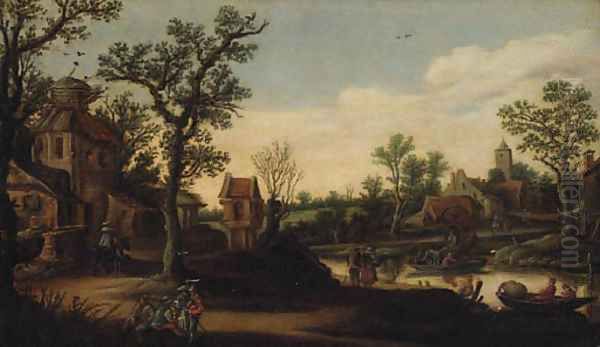
Works like View of Zierikzee (1618, Gemäldegalerie, Berlin) demonstrate his ability to create topographical views, blending landscape with an accurate portrayal of a specific town. Genre scenes like Garden Party Before a Palace (c. 1614-1615) or Cavalry Engagement highlight his versatility beyond pure landscape. Across his oeuvre, a consistent commitment to observation, naturalistic representation, and skillful composition is evident.
Relationships with Contemporaries
Esaias van de Velde's career unfolded within a vibrant artistic community, and his interactions with other painters were crucial to his development and influence. His relationship with Jan van Goyen is perhaps the most significant. Van Goyen studied with Van de Velde in Haarlem around 1617-1618. While the apprenticeship was brief, its impact was profound. Van Goyen absorbed Van de Velde's realistic approach, his compositional strategies (like the use of diagonals and low horizons), and his focus on local scenery. However, Van Goyen would later develop his own distinctive style, pushing towards the more monochromatic palette and looser brushwork of the tonal phase. Despite these later divergences, Van de Velde provided the essential foundation for Van Goyen's hugely successful career.
His connection with Willem Buytewech in Haarlem was also important, likely involving a mutual exchange of ideas, particularly regarding the depiction of contemporary figures and genre themes. Both artists contributed significantly to the development of genre painting in the early Dutch Golden Age.
Other contemporaries included Pieter de Molijn, who also worked in Haarlem and became a prominent landscape painter, likely influenced by Van de Velde. Although slightly older, artists like Roelant Savery and David Vinckboons represented the Flemish tradition from which Van de Velde departed, providing a contrasting backdrop against which his innovations stood out. The experimental and unique landscapes of Hercules Segers, another Haarlem contemporary, offer a fascinating, albeit very different, approach to landscape during the same period. The broader Haarlem milieu also included the towering figure of Frans Hals, whose dynamic portraiture paralleled the move towards realism seen in landscape and genre.
Influence and Lasting Legacy
Esaias van de Velde's impact on the course of Dutch art history was substantial and enduring. His primary legacy lies in his role as a founder of the Dutch realistic landscape tradition. By turning away from Mannerist artifice and focusing on the direct, naturalistic portrayal of his native environment, he set a course that would dominate Dutch painting for much of the 17th century.
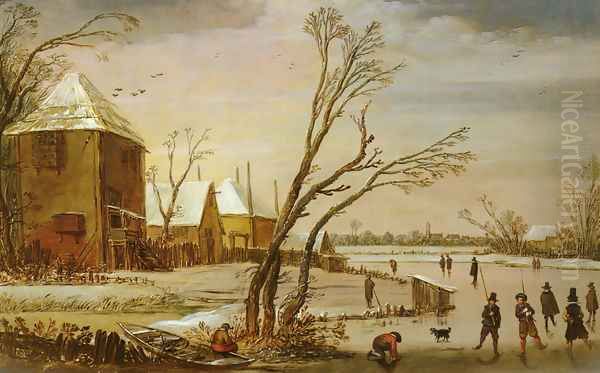
His most immediate influence was on his pupils. Jan van Goyen became a leading master of the tonal landscape. Pieter de Molijn developed a successful career painting landscapes in a style clearly indebted to Van de Velde. Pieter van Laer, known as "Il Bamboccio," studied with Van de Velde before traveling to Rome, where he became famous for his small-scale genre scenes of Roman street life, initiating the style known as "Bamboccianti." Other followers included Jan Martensz. de Jonge and Pieter van Santvoort, who perpetuated his landscape style.
Beyond his direct students, Van de Velde's innovations paved the way for the next generation of great Dutch landscape painters. Artists like Salomon van Ruysdael (who may have also studied briefly with him or was certainly influenced via Van Goyen and Molijn) and his nephew, the celebrated Jacob van Ruisdael, built upon the foundations of realism that Van de Velde helped establish, further developing atmospheric effects and compositional complexity. Even later masters like Aelbert Cuyp, known for his idyllic landscapes bathed in golden light, and Meindert Hobbema, famous for his wooded scenes, are part of the broader tradition that traces its roots back to the pioneering efforts of Esaias van de Velde and his contemporaries in Haarlem.
His influence also extended through his prints. Van de Velde was an accomplished etcher, producing series of landscapes that helped disseminate his compositional ideas and realistic approach to a wider audience, including other artists.
Anecdotes and Contextual Notes
While detailed biographical information is sometimes scarce for artists of this period, a few contextual points add color to Van de Velde's story. His family's background as Protestant refugees from Flanders highlights the significant impact of migration and religious conflict on the cultural landscape of the Dutch Republic. This influx of talent from the Southern Netherlands undoubtedly enriched the artistic scene in cities like Amsterdam and Haarlem.
An incident recorded in 1626, where Van de Velde was involved in a legal dispute, accused of slandering another individual, offers a glimpse into the social dynamics and potential rivalries within the art world of The Hague. Such disputes were not uncommon in a competitive market where reputations mattered.
The demand for Van de Velde's work during his lifetime attests to the growing appreciation for realistic depictions of Dutch life and landscape among the increasingly prosperous merchant class and citizenry. His ability to work across different genres – landscape, winter scene, merry company, military scene – likely broadened his appeal and marketability.
Conclusion: A Quiet Revolutionary
Esaias van de Velde may not possess the dramatic flair of some Baroque masters or the widespread name recognition of Rembrandt or Vermeer, but his contribution to art history is undeniable and fundamental. He was a quiet revolutionary who, through careful observation, technical skill, and a commitment to depicting the world around him, fundamentally shifted the direction of landscape painting in the Netherlands. He bridged the gap between the lingering Mannerist traditions of the late 16th century and the full flowering of Dutch Golden Age realism. His focus on local scenery, his development of naturalistic compositions and atmospheric effects, and his skillful integration of figures laid the essential groundwork upon which subsequent generations of celebrated Dutch landscape painters built their own achievements. His works continue to be admired for their tranquil beauty, their detailed observation, and their historical significance as foundational documents of Dutch realistic art.